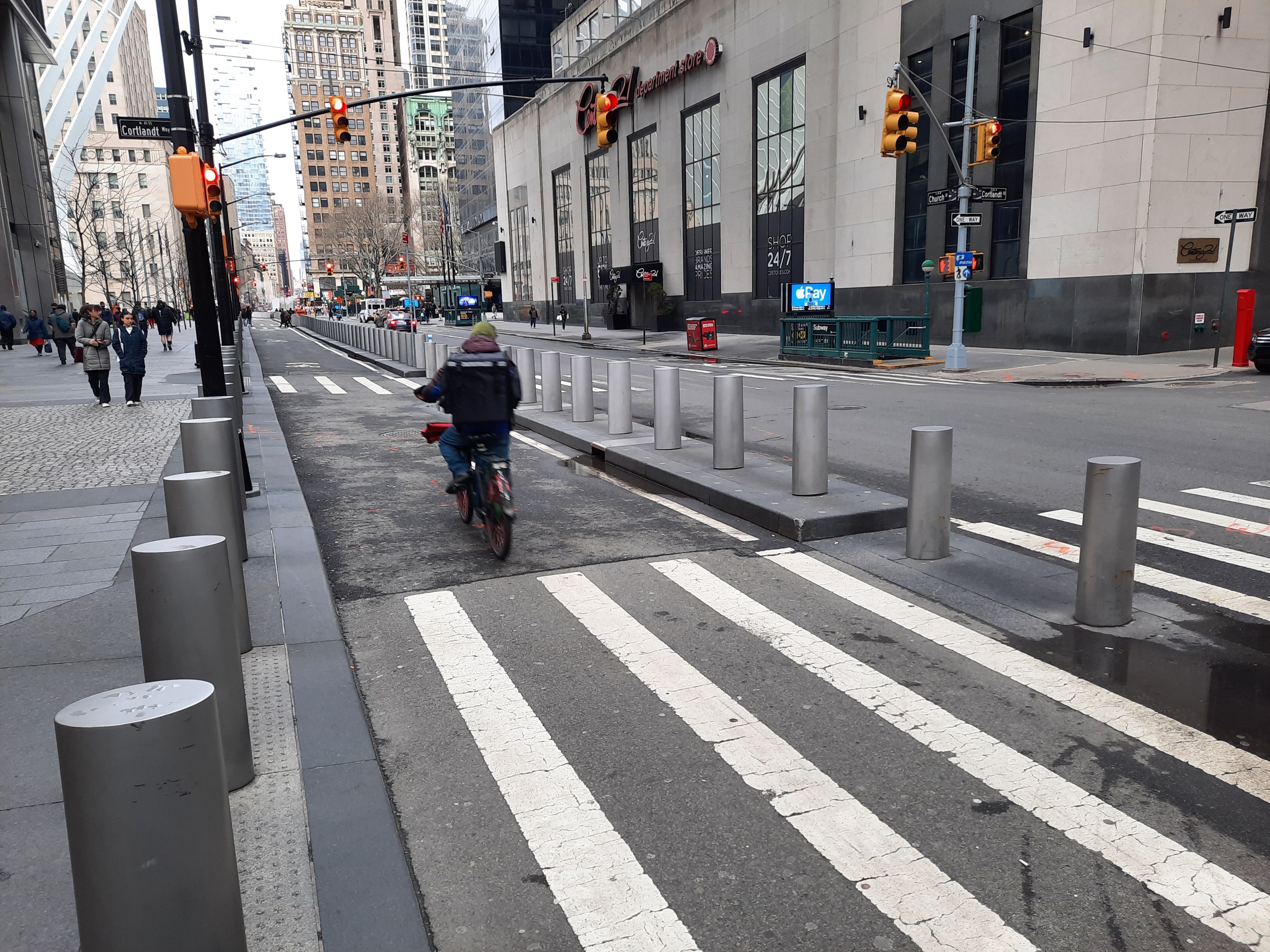Unprotected "protected" bike lanes — the perpetual thorn in cyclists' side.
But deaths and injuries resulting from inadequate protection are not only preventable, but preventable using methods that are certainly not foreign to the city Department of Transportation. Just look at the Church Street "protected" bike lane, which is really just the World Trade Center security inspection perimeter that happens to have a bike lane logo stenciled onto it.
By accident, this mile-long stretch has become one of the safest bike lanes in New York:
Praying on Church
This quirk in the Lower Manhattan street grid, running northbound from Cedar Street to Vesey Street, is the product of post 9/11 anti-terrorism fears. It was constructed in 2013 as part of a broader perimeter protection project for the complex and features vehicle checkpoints at both ends, movable metal barriers to let authorized vehicles in and keep unauthorized vehicles out, closely spaced metal bollards, metal barriers at intersecting streets.
Bottom line: it's impossible for unauthorized vehicular traffic from Church Street and intersecting streets to turn into this uber-protected bike lane. Check it out the stretch between Cedar and Liberty streets here:

As a security measure for the World Trade Center, it is extremely effective at keeping unauthorized vehicles out. And in the process, due to its concurrent openness to pedestrians and cyclists, it’s created New York’s closest equivalent to on-street cycling heaven, as the protections mean the problems attached to New York's normal “protected” bike lanes simply don't exist here.:

With unauthorized vehicles not being allowed in, even at intersections, cyclists don’t have to think twice or twist their heads before moving through it, creating a fully predictable and stress-free environment. There can be traffic on the lane occasionally if an authorized vehicle is allowed through, but this is sporadic enough to not be a constant presence, leaving the lane mostly empty for cyclists to enjoy. The only thing cyclists have to look out for is pedestrians.
The safe and simple environment created by the bollards is a respite from the chaotic traffic movements that can surround it; the only disappointing thing one could say about the lane is that it’s only northbound and is wide enough to easily support two-way bike traffic.
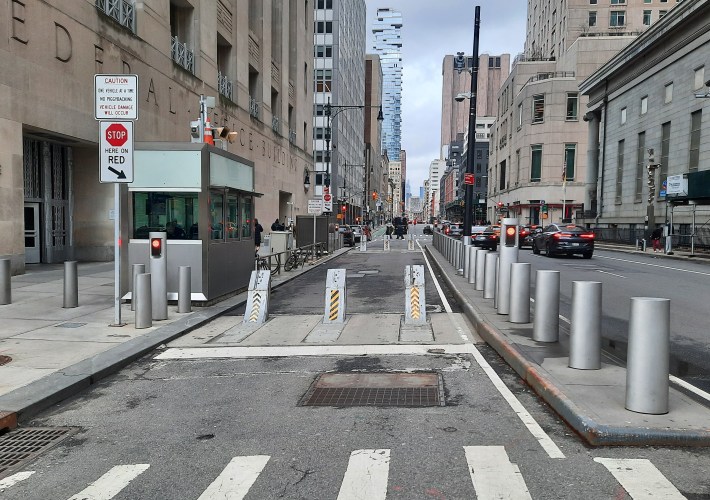
To better demonstrate the superiority of a bollard-protected lane, it's wise to look a block east to Broadway, where there's a normal parking "protected" bike lane. Parts of that lane are an abject mess, with the access flaws in its parking protection scheme showing themselves repeatedly where trucks and vans, some of the variety which are illegal to operate in Manhattan, are illegally parked in it:
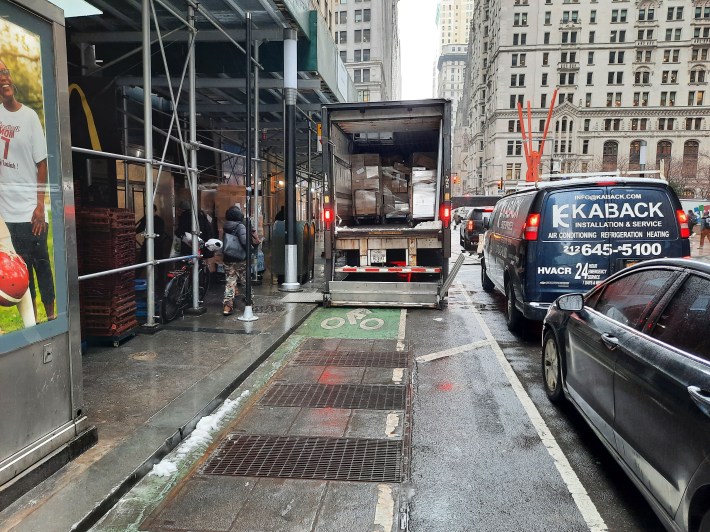
Mixing zones are present, and in keeping with the safety risks all bike lane users experience from aggressive drivers barrelling through them, it’s very easy to tell where drivers have taken shortcuts through them, along with other plastic “protected” parts of the lane, where plastic traffic barriers are absent or broken off their bases:
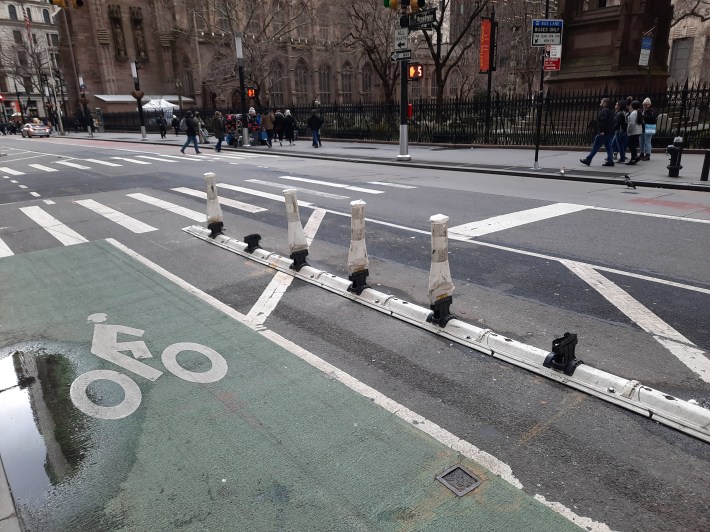
The DOT has bolstered parts of the lane with jersey barriers, but they’re sporadic, leaving cyclists with only a few blocks of fixed protection in what is billed as a completely safe bike lane. This is apparent at Fulton Street, where there is one jersey barrier and some some plastic flex posts. The cement barriers provide a reasonable expectation of safety; the plastic, less so:

It's interesting to consider that the Church Street bike superhighway is not the only bollard-protected bike infrastructure in the city — but it's also sad to consider that both Church Street and the nearby Hudson River Greenway provide cyclists extra protection simply because of a terror attack.
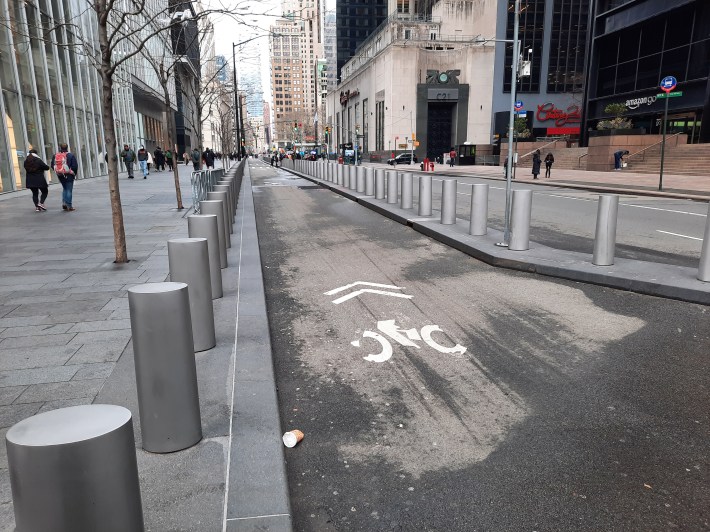
Jessie Singer, in describing her motivation to write the book, There Are No Accidents, recently reminded The War on Cars podcast that the Greenway only received bollard protection after Sayfullo Saipov was able to commit a deadly terror attack on it. Yet when a drunk driver killed a cyclist in almost the exact same place on the Greenway, no improvements were made.
But this kind of inaction is common. Last month, the family of Sarah Schick, who was killed on Ninth Street in Brooklyn by a truck driver, announced a $100-million lawsuit against the city for negligence because it had declined to add safety infrastructure on that part of the roadway, despite knowing the dangers.
“Paint is not a protection. And promises don’t save lives. So what’s different this time?” asked lawyer Sam Davis.
